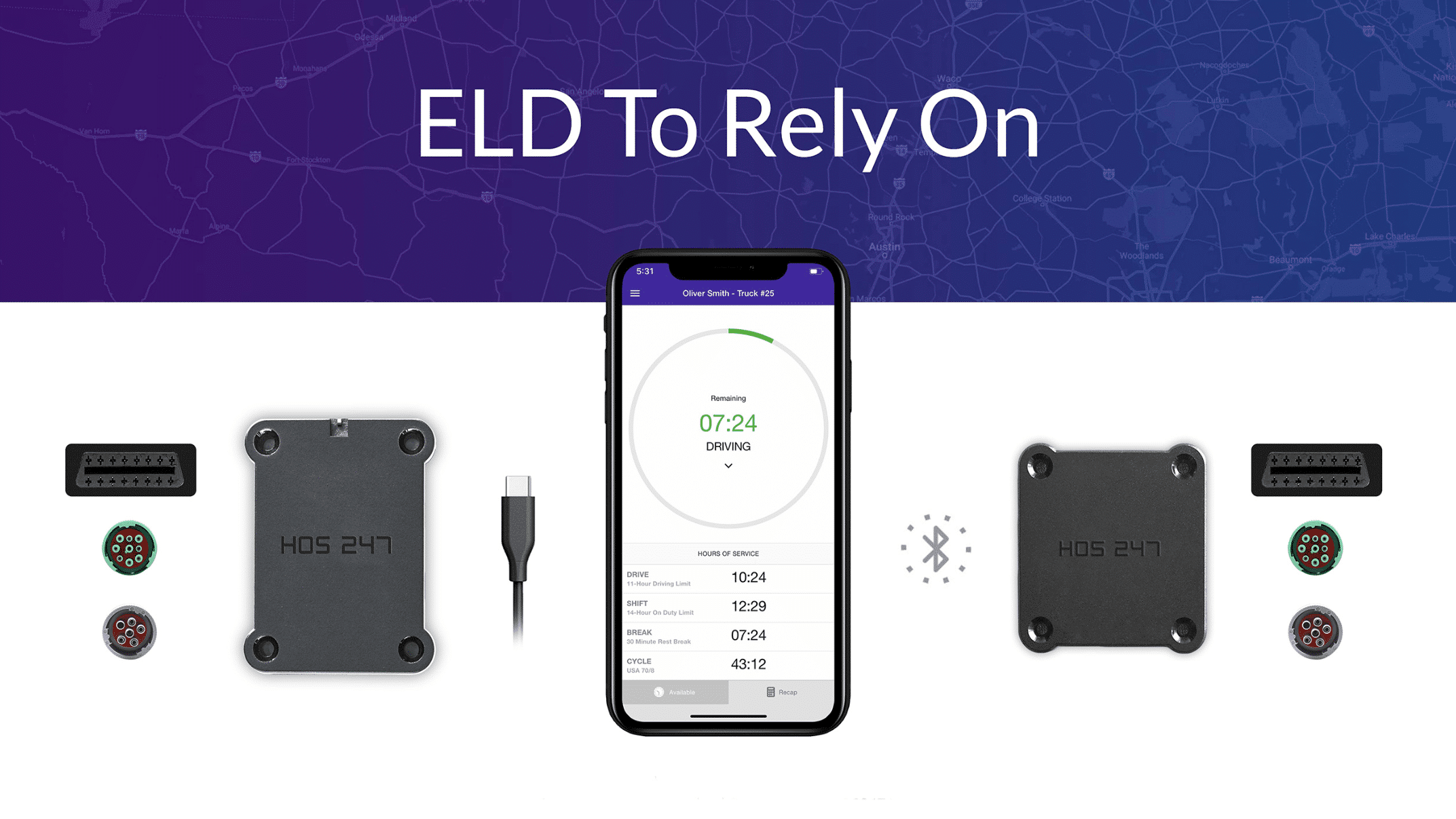Prior to the implementation of the ELD law, commercial motor vehicle operators holding a commercial driver’s license (CDL) were allowed to maintain records of their duty status using paper logs. These logs required drivers to manually document changes in their driving status over a 24-hour period. However, with the full implementation of the ELD mandate in 2023, most CMV drivers in Canada were required to transition to electronic logs. ELDs provide a higher level of precision as they are directly connected to the vehicle’s engine, accurately recording hours of service information.
While there are exemptions for certain drivers who are still allowed to use paper logs to document their duty status, most drivers who operate across provincial lines are subject to the ELD regulations. To legally operate, they are required to use an electronic CDL log book. This article aims to assist drivers in avoiding penalties and fines associated with non-compliance by exploring reliable ELD options and providing useful information on the legislative and technical aspects of CDL driving regulations in Canada.
How Many Hours a Day Can a CDL Driver Drive?
CDL driving rules in Canada impose limitations on the operating, working, and resting time of commercial motor vehicle (CMV) drivers. These rules differ based on the zone of operation, categorized as Canada South or Canada North. In each zone, Canadian CMV operators are required to comply with specific CDL driving hours regulations, encompassing the following key rules:
Daily driving limit:
- Canada South: CMV operators are limited to a maximum of 13 hours of driving time in a day.
- Canada North: Drivers are restricted to a maximum of 15 hours of driving within a shift.
Daily on-duty limit:
- Canada South: CMV operators are allowed to be on-duty for a maximum of 14 hours in a day, including driving time.
- Canada North: Drivers cannot drive after accumulating 18 hours of on-duty time within a shift.
Shift/workday limit:
- Canada South: CMV operators must not drive after 16 consecutive hours have elapsed in a shift.
- Canada North: Drivers must not drive after 20 consecutive hours have elapsed in a shift.
Mandatory off-duty time:
- To reset a shift and restart on-duty and driving hours, drivers need to be off-duty for 8 consecutive hours in both operational zones.
Typically, commercial vehicle drivers subject to hours of service (HOS) regulations are required to use electronic logging devices (ELDs) to accurately record their on- and off-duty hours for roadside inspections. However, drivers and motor carriers may be exempt from this rule under certain circumstances, allowing them to manually record their logbooks. These exemptions include:
- CMV drivers operating under a rental agreement that is no longer than 30 days and is not extended for the same vehicle.
- Vehicles manufactured before the year 2000.
- Motor carriers operating under a federal permit issued by a provincial director.
- Motor carriers operating under an exemption granted under section 16 of the Motor Vehicle Transport Act.
Additionally, short-haul drivers who operate within a 160 km radius from their work location are exempt from the ELD law and use time cards instead of logbooks. If none of these exemptions apply to your trucking business, prioritizing the search for a reliable electronic CDL driver log book is crucial. However, choosing a suitable solution can be challenging due to the variety of options available in the Canadian market. In the next section, we will introduce a dependable Transport Canada-approved ELD that can help facilitate compliance and streamline your fleet operations.

Enjoy the Benefits of a Quality CDL Log Book with HOS247
HOS247 is a leading ELD provider that meets all applicable HOS requirements. Our solution stands out from other CDL log books for its efficiency, reliability, and excellent customer support, which are the main reasons truckers choose HOS247 ELD. Some of the benefits provided by our solution include:
- Effective technical support. As user reviews on the Apple App Store and Google Play platforms show, our clients highly appreciate the HOS247 customer support for the efficiency and friendliness of our multilingual tech experts available from Monday to Sunday. In addition, our callback policy guarantees that if the call drops, your rep will contact you right away.
- Straightforward interface. Designed to be accessible and easy to use, the app can be paired with both iOS and Android operating systems to run smoothly on any phone or tablet. With the HOS247 app, drivers can easily update their driving status and create vehicle inspection reports, while fleet managers can access valuable metrics collected by the device through the web-based portal.
- Compatible hardware. If you own vehicles of different classes, you need a device that is compatible with all of them. The HOS247 hardware is compatible with most vehicles, and can be set up in minutes without requiring special installation.
- No-contract policy. With a flexible system of monthly or yearly subscriptions that can be easily upgraded or downgraded, our customers don’t have to worry about being locked into long-term contracts. Our clients stay because of the quality of our service; they do not have to commit for years in advance.
- Two-week trial. At HOS247, we encourage our customers to test our solution for 14 days before making a decision, so they can put the system to the test and decide if it suits their business needs.
- Extra features. The HOS247 ELD can be integrated with real-time GPS tracking, IFTA calculations, idle reporting, and vehicle diagnostics, allowing truckers to reduce operational costs and significantly boost the productivity of operations.
Improve Trucking Operations the HOS247 All-in-One Vehicle Fleet Management Solution
In addition to providing a reliable ELD solution to enhance your compliance efforts, HOS247 offers a comprehensive suite of all-in-one vehicle fleet management solutions. Our goal is to streamline your operations and foster a culture of safety within your fleet.
With HOS247, you can leverage advanced technology to gain real-time insights into your fleet’s performance, optimize routes, monitor driver behavior, and simplify compliance with industry regulations. Let’s explore the features that enable these capabilities:
- Real-time GPS tracking. This tool enhances vehicle and driver security, facilitates dispatch, improves customer service, and provides full fleet visibility. With GPS trackers that can be concealed inside the vehicle, motor carriers can also secure their assets and prevent vehicles from being utilized for unauthorized purposes.
- Vehicle maintenance. When maintenance is done on time, it can significantly cut repair expenses, extending vehicles’ lives. This feature tracks and schedules maintenance events based on hours of usage, keeping a record of past service history and malfunctions reported by drivers.
- Fault code detection. If the system finds a malfunction, it generates a specific trouble code corresponding to a fault detected in the vehicle and notifies the fleet manager. This tool also contributes to enhancing vehicles’ longevity to maximize carriers’ investments.
- IFTA calculations. Automated IFTA calculations eliminate audit risk and human error by tracking the distance traveled by a vehicle in each IFTA jurisdiction, making tax reporting easier.
- Idle reporting. Besides being harmful to the environment, idling may result in additional fuel expenses due to wastage. This feature helps fleet managers monitor and correct drivers’ behavioral patterns, reducing fuel consumption and cutting fuel costs.

How to Fill Out the Truck Drivers Log Book
There are various circumstances in which a commercial vehicle driver may need to fill out a log book using paper logs. As previously discussed, HOS exemptions allow operators to maintain manual records, and device malfunctioning can also necessitate the use of analog logbooks. While completing the form is not overly complex, it requires precision and attention to detail to comply with CDL logbook rules. Let’s take a closer look at the process.
The contents of a log book include:
- Date
- Name of carrier
- Truck number
- Total number of kilometers driven within a 24-hour period
- Starting time of the 24-hour period
- Names of all co-drivers
- Shipping document specifying the carrier and commodity being transported.
If the operator drives multiple vehicles within the fleet, this information should also be reflected in the logbook. Additionally, the operator should indicate the origination point in the “from” line and the destination in the “to” line.
Tracking Activities on the Graph Grid

The graph grid of a CDL log book serves as a vital tool for tracking a driver’s activities during their working shift. It is divided into 24 boxes, with each box representing one hour of the day and marked with fifteen-minute intervals.
The grid contains four sections that indicate the driver’s activities: off-duty, sleeping, driving, or on-duty and not driving. To record their duties, the operator must draw a straight horizontal line through the relevant activity, indicating the start and end time. When the duty changes, drivers should denote this by drawing a vertical line from the first mark of the previous duty to the next one. After each duty, truckers should leave comments in the remarks section, providing specific information about the location. The more precise the information, the better.
Once the logbook is completed, drivers must tally the number of hours worked and double-check to ensure it totals 24. They should also correct any mathematical and grammatical errors and ensure that the recorded information is legible.
CDL driving regulations are extensive and can be challenging to adhere to. However, a reliable electronic logbook can greatly facilitate administrative tasks for both drivers and managers. HOS247’s dependable and user-friendly devices, combined with our comprehensive fleet management solutions, provide a seamless experience for managing your logs and maximizing operational efficiency. Order a demo and try our devices for two weeks to see how easy keeping a CDL log book can be.

As an expert in B2B and B2C sales, I’ve dedicated myself to perfecting sales processes and client retention strategies in the logistics and trucking industry. I have significantly contributed to the expansion of the ELD service, catering to retail and wholesale clients in need of HOS247 ELD solutions. My unwavering commitment to implementing state-of-the-art sales techniques and technologies ensures the continuous growth and success of businesses I work with.












The data collected by fleet tracking devices can be used to optimize processes, reduce costs and increase driver safety, improving the business’s bottom line. That said, there’s no doubt that using a fleet vehicle tracking device is a worthwhile investment,

For commercial truck drivers, electronic logging devices (ELDs) are more than just another piece of technology — they’re essential tools that directly impact compliance, efficiency, and financial bottom line. Choosing the best app to log driving hours can mean the

Since the ELD mandate took effect in 2021, electronic logbooks have become an integral working tool both for CMV drivers and fleet managers in Canada. But what does ELD stand for? ELD stands for electronic logging device. What are electronic